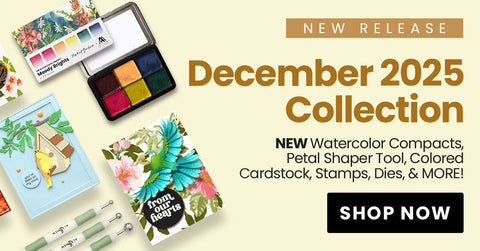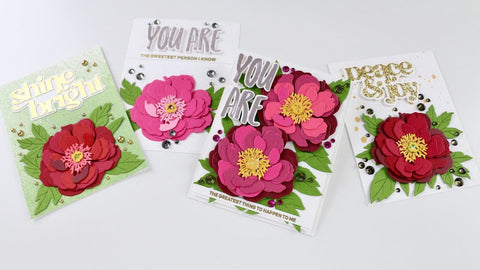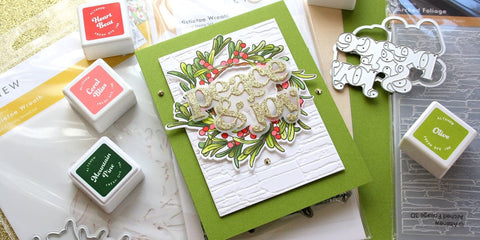How to Use Watercolor Paint Tricks in Cardmaking
Last Updated: October 29, 2025
Whether you're a beginner or an experienced crafter, watercolor paint is an essential medium to use in your card designs! It's a versatile tool that produces astounding results. If you want to incorporate more watercolor techniques in your projects, let this article inspire you to try these effective watercoloring tricks!

Artists' Watercolor 24 Pan Set
Different Watercoloring Tips to Make Your Cards Unique
When it comes to watercoloring in cardmaking, you don't have to be a painter to create the inky designs you see in our inspirational blog posts. All you need are the proper watercoloring materials and your creativity! You can employ various hacks that will make working with water-based coloring mediums easier than you think. If you are just starting with watercolors and are looking for simpler techniques, we recommend reading: 12 Watercolor Techniques You Must Try (Beginner-Friendly!)
In this article, we will inspire you to go beyond simple watercoloring and try out new techniques to make your cards pop with beautiful color washes and gradients.
Watercoloring Your Designs Through Prominent Strokes
If you're looking for a new watercolor technique to explore, try doing the "prominent stroke" method commonly used in acrylic and oil paintings. This method is a cool way to watercolor paint with just one color and create artsy-looking projects. The prominent stroke technique uses varying shades of a single pigment, so you can achieve light and shadow effects on your painting, as shown in this video tutorial by Erum. She painted an image from Paint-A-Flower: Flowering Dogwood Stamp Set using her Artists' Watercolor 24 Pan Set -- watch how she does it below:
This technique is fun and will give your floral images an exciting look. You can also play around with different hues by using the outlines on the stamped images as guides for where to put darker strokes. Through light and shadows, watercoloring with this technique gives your images more depth than just painting in solid colors!

Paint-A-Flower: Flowering Dogwood Outline Stamp Set
Another Watercoloring Tip - Heat Embossing to Contain Colors

Watercoloring White Embossed Images
To make your cards look distinguished with out-of-this-world designs, try watercoloring embossed images. You can try this technique with the Altenew Artists' Watercolor 24 Pan Set. Then, all you need is some embossing ink and embossing powder, and you're good to go!
This watercoloring trick is perfect for images with larger and more open areas. A perfect way to try this out is with galaxy colors, as seen in Jenny's inspiring video on her Stylish Cardmaking Techniques Series:
First, stamp the image with embossing ink. After heat setting with embossing powder, you can start watercoloring. Don't worry about coloring within the lines - heat embossing will preserve your image and allow you to experiment and color freely.
After letting it dry, you can either die-cut or fussy-cut the image. Pop up the image on your card by using foam tapes to make it look more 3D! The finished product features a remarkable design that will give life to your cards. Isn’t the process a different and fun way to watercolor?
Using Alcohol Markers with Watercolors
Another great watercoloring hack for your next great project idea is to combine watercolor paint with Altenew Alcohol Markers. It's a combination that would work well for attention-catching and vibrant color-shading designs. Using alcohol markers with watercolors allows detailed coloring and blending of highlights and shadows, giving your images a more realistic look.

Paint-A-Flower: Camellia Outline Stamp Set
For a great example of how Altenew Alcohol Markers blend well with watercoloring backgrounds, here is a cardmaking inspiration made by Erum with the Paint-A-Flower: Camellia Outline Stamp Set:
To get this similar result on your cardmaking projects, you can follow these steps:
- Color your die-cut images using Altenew Alcohol Markers.
- Then, stamp the outline image with Obsidian Pigment Ink, which will help your image last longer and resist water. You can choose to skip this step if you want your colors to look softer rather than bold.
- Finally, using the Artists' Watercolor Pan Set, give the background a soft color wash. Using water and a brush, you can play with the hues to create a dripping effect.

Artists' Watercolor 24 Pan Set
This technique is more time-consuming than the other watercoloring tips mentioned, but the result will be worth it! The contrast between the soft color wash of the watercolor and the outline image will surely make your card shine.
Did You Know That You Can Also Create Watercolor Looks With Other Mediums?

Coloring with Alcohol Ink Backgrounds
You don't always need your watercolor paint to achieve the tie-dye effect of watercolor on your designs. In fact, with Altenew Alcohol Inks, you can create ink backgrounds using just the following materials:
Creating Alcohol Ink Backgrounds
- Altenew Alcohol Ink
- Blending Solution
- Ink Air Blower
- Blending Brush (If you want a gradient look)
- Yupo Paper
Discover a new way to color your following projects with Altenew Alcohol Inks! Watch this video from our designer, Lydia to see this technique in action. She shows how she used these inks for her Airbrushed Flowers Stamp Set and created a beautiful watercolor background with just a few ink splatters on yupo paper:
You can try mixing the alcohol ink drops with a bit of blending solution, then controlling their flow with an ink air blower. This technique will give you a beautiful and light color wash - we recommend using two or three complementary colors to get the best outcome!
If you want a more gradient or marble-like design, you can also use this technique by using darker colors first, then work your way with lighter shades. Blend the colors using a blending solution and a brush or blower, then voila! You can now create cards with beautiful splashes of ombre colors and textures.
You can see these techniques in Therese’s tutorial on creating fun backgrounds with Altenew Alcohol Inks:
Learn More Watercoloring Tips on the Altenew Blog

Watercolor Essential 12 Pan Set
The next time you work with watercolors in your project, try these three effective watercolor paint tricks to elevate your cards.
Watercoloring in cardmaking involves a lot of techniques, but the greatest thing to remember is to have fun and learn! After all, watercoloring is an excellent medium to use when it comes to trying out more card arrangements and looks.
With enough practice and inspiration, you will soon discover more fantastic ways of incorporating watercolors to create stunning projects.
Check out our All About Crafting page for more crafting inspiration and tips on using watercolors in your designs and works. Thanks for joining us today, and we hope you have a great time exploring the possibilities of watercolors!
















Hi Noreen! Thanks for stopping by. We’re glad you found this useful and inspiring. Hope to see your watercolor projects soon!
So much inspiration!